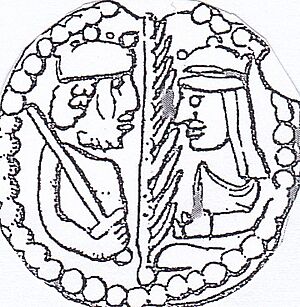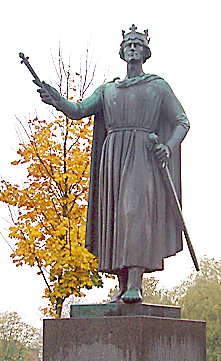Valdemar I of Denmark facts for kids
Quick facts for kids Valdemar I |
|||||
|---|---|---|---|---|---|

This old coin shows Valdemar and his wife, Sophia.
|
|||||
| King of Denmark | |||||
| Reign | 1154 – 12 May 1182 | ||||
| Predecessor | Sweyn III | ||||
| Successor | Canute VI | ||||
| Born | 14 January 1131 Schleswig, Denmark |
||||
| Died | 12 May 1182 (aged 51) Vordingborg Castle, Vordingborg, Denmark |
||||
| Burial | St. Bendt's Church, Ringsted, Denmark | ||||
| Consort | Sophia of Minsk | ||||
| Issue Detail |
|
||||
|
|||||
| House | Estridsen | ||||
| Father | Canute Lavard, Duke of Schleswig | ||||
| Mother | Ingeborg of Kiev | ||||
Valdemar I Knudsen (born January 14, 1131 – died May 12, 1182) was a powerful king of Denmark. He is often called Valdemar the Great. He ruled Denmark from 1154 until he passed away in 1182. During his time, Denmark grew much stronger. The country became even more powerful under his son, King Valdemar II.
Contents
Valdemar's Early Life
Valdemar was the son of Canute Lavard. Canute was a duke and a very popular leader. He was also the oldest son of King Eric I of Denmark. Sadly, Valdemar's father was killed by King Magnus I of Sweden just days before Valdemar was born.
Valdemar's mother was Ingeborg of Kiev. She was the daughter of a grand prince from Kiev. She named Valdemar after her own grandfather.
Growing Up in a Noble Family
Valdemar grew up in Ringsted. He lived at the court of a Danish nobleman named Asser Rig. Asser Rig was a member of the important Hvide noble family. He had grown up with Valdemar's father, Canute Lavard.
Valdemar was raised with Asser Rig's own sons. These included Absalon and Esbern Snare. Absalon later became an important church leader, an archbishop. He often fought alongside Valdemar in battles. Esbern Snare was a royal helper and a crusader. Esbern and Absalon were very close friends. They formed a strong team with Valdemar.
Becoming King of Denmark
In 1146, when Valdemar was fifteen, King Eric III of Denmark gave up his throne. This caused a civil war in Denmark. Valdemar was one of the people who wanted to become king.
The Fight for the Throne
There were two other main people who wanted to be king. They were Sweyn III Grathe and Canute V. Both of them declared themselves King of Denmark in 1146. The civil war lasted for almost ten years.
In 1154, Valdemar joined forces with Canute. They agreed to rule Denmark together as co-kings. In July 1157, they made a temporary agreement. The three rivals decided to divide the country among themselves. They would rule different parts of Denmark.
Valdemar Becomes Sole Ruler
In August 1157, Canute was killed at a feast in Roskilde. Later, Valdemar fought Sweyn at the Battle of Grathe Heath. This battle happened on October 23, 1157. Valdemar defeated Sweyn. Sweyn was killed while trying to escape. He was supposedly found by farmers as he fled the battlefield.
Since Valdemar had outlived all his rivals, he became the only king of Denmark.
Valdemar's Reign
After becoming king, Valdemar made Absalon his main advisor. Absalon was elected the bishop of Roskilde in 1158. King Valdemar worked to rebuild Denmark, which had been damaged by war.
Protecting Denmark's Borders
Valdemar made the Dannevirke fortifications stronger in the south. These were important defenses. He also built Sønderborg Castle. This was a strong fortress on a small island. It was later connected to Als Island.
Valdemar also used old Viking fighting methods. He changed them to work with heavy cavalry. This helped him fight the Wends to the south. The Wends were a big threat. His successor, Canute VI, made these fighting methods even better.
Fighting the Wends
Absalon encouraged Valdemar to declare war on the Wends. The Wends were attacking Danish coasts. They had taken over Pomerania and the island of Rügen in the Baltic Sea. The Wends had many more people than the Danes.
So, the Danes started attacking the Wendish coasts. This led to the conquest of Rügen. Rügen became a base for the Danes to attack and take over more Wendish land. Danish power reached Pomerania and the Obotrite confederacy. These areas were often raided by the Danes.
Around 1170, a small part of the Danish fleet, led by Valdemar and Absalon, sailed past the Oder river. They were surprised by a Wendish army and fleet at the Julin bridge. The Wends hoped to stop the Danish attacks. But the Danes were smarter. They defeated the Wendish army and fleet. This was mainly because the Danish ships also carried soldiers on horseback.
In 1175, King Valdemar built Vordingborg Castle. This was a defensive fortress. It was also a place to start more attacks against the German coast.
Dealing with Unrest in Scania
In 1180, there was trouble in the rich area of Scania. The people there wanted Valdemar to replace the governors from Jutland. They wanted local nobles from Scania to rule them instead. They also completely refused to pay church taxes.
Valdemar said no to their demands. So, the people of Scania rebelled. They said they would not pay any taxes or church tithes. There were so many rebels that Valdemar had to gather his own soldiers and soldiers from Blekinge. The armies met at the Battle of Dysiaa. Valdemar crushed the rebellion. After this, the people started paying taxes again.
Even though the peasant army surrendered, they still refused to pay church tithes. So, Valdemar made them give generous gifts and donations to the church instead. They would not pay tithes, but they would still pay money. The only thing Valdemar agreed to was changing the governors. He replaced them with people from Scania. This idea, that a local person should rule their own area, was then used across the Danish kingdom. This helped keep peace in the kingdom and the larger areas Denmark later controlled.
Valdemar's Family
Valdemar married Sophia of Minsk. She was born around 1141. Sophia was the daughter of Richeza of Poland. She was also the half-sister of King Canute V of Denmark.
Valdemar and Sophia had many children:
- Sophia (1159–1208), who married Siegfried III, Count of Weimar-Orlamünde.
- Canute VI of Denmark (1163–1202)
- Maria (born around 1165), who became a nun in Roskilde in 1188.
- Margaret (around 1167–1205), who also became a nun in Roskilde in 1188.
- Valdemar II of Denmark (1170–1241)
- Ingeborg (1174–1237), who married King Philip II of France.
- Helena (around 1176 – 1233), who married William, Duke of Brunswick-Lüneburg.
- Richeza (around 1178 – 1220), who married King Eric X of Sweden.
- Walburgis (died 1177), who married Bogusław I, Duke of Pomerania.
After Valdemar died, Sophia married another ruler, Louis III of Thuringia.


